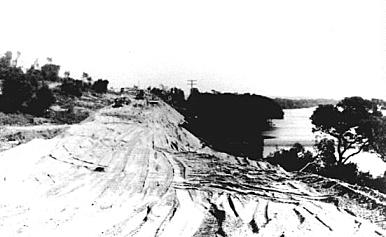Access and Sevices |
Getting on With the Road
In 1950 the Captain Cook's Landing Place Road Trust applied for assistance to build the road. Council, on 30 th October the same year, dedicated a strip of land 80 feet wide for the road to Kurnell and named it 'The Captain Cook Drive'. Another three years elapsed before the road was begun. In 1953, Caltex Oil Refinery paid Sutherland Council 50,000 towards its construction and Council added a 30,000 Federal Aid Grant it had received. On Saturday, 28 th February 1953, the State Premier, Mr J.J. Cahill, driving a bulldozer, turned the first sod at the Cronulla end, adjacent to the entrance to Towra Point.
The construction of the road was no mean feat. Teams worked from both the Cronulla and the Kurnell ends, laboriously making their way towards a central meeting point. Apart from bush, bogs and sand, the workmen had to contend with the mosquitoes and the snakes, both of which appeared in large numbers. Four months after turning the first sod the unsealed, unfinished road was open to traffic, though work on some parts was continuing. |

 |
| There was controversy over the thickness of the roadbed. Caltex complained that Council was making it too thick, doing too good a job, costing too much money. these and other points caused work to stop on a number of occasions. Following a legal conference, the original agreement was cancelled and a new one was drawn up that required Council to complete the road by August 1954. Caltex limited its financial contribution to what it had already paid, being the sum of 155,956. Federal Aid Grants covered the balance. The final cost of the road was 181,456. At the end of July 1954, the road opened to all traffic. |
| top of page |



